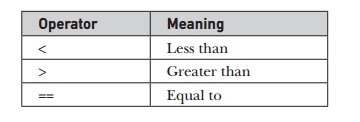Chapter: Java The Complete Reference : The Java Language : An Overview of Java
Two Control Statements
Two Control Statements
Although Chapter 5 will look closely at control
statements, two are briefly introduced here so that they can be used in example
programs in Chapters 3 and 4. They will also help illustrate an important
aspect of Java: blocks of code.
The if Statement
The Java
if statement works much like the IF
statement in any other language. Further, it is syntactically identical to the if statements in C, C++, and C#. Its
simplest form is shown here:
if(condition) statement;
Here, condition
is a Boolean expression. If condition
is true, then the statement is executed. If condition
is false, then the statement is bypassed. Here is an example:
if(num < 100)
System.out.println("num is less than 100");
In this case, if num contains a value that is less than 100, the conditional
expression is true, and println( )
will execute. If num contains a
value greater than or equal to 100, then the println( ) method is bypassed.
As you will see in Chapter 4, Java defines a
full complement of relational operators which may be used in a conditional
expression. Here are a few:

Notice
that the test for equality is the double equal sign.
Here is
a program that illustrates the if
statement:
/*
Demonstrate the if.
Call this file
"IfSample.java".
*/
class IfSample {
public
static void main(String args[]) {
int x,
y;
x = 10; y = 20;
if(x < y)
System.out.println("x is less than y");
x = x * 2;
if(x == y)
System.out.println("x now equal to y");
x = x * 2;
if(x > y)
System.out.println("x now greater than y");
// this won't display
anything
if(x == y)
System.out.println("you won't see this");
}
}
The
output generated by this program is shown here:
x is less than y x now equal to y
x now greater than y
Notice
one other thing in this program. The line
int x, y;
declares
two variables, x and y, by use of a comma-separated list.
The for Loop
As you
may know from your previous programming experience, loop statements are an
important part of nearly any programming language. Java is no exception. In
fact, as you will see in Chapter 5, Java supplies a powerful assortment of loop
constructs. Perhaps the most versatile is the for loop. The simplest form of the for loop is shown here:
for(initialization; condition; iteration)
statement;
In its most common form, the initialization
portion of the loop sets a loop control variable to an initial value. The condition is a Boolean expression that
tests the loop control variable. If the outcome of that test is true, the for loop continues to iterate. If it is
false, the loop terminates. The iteration
expression determines how the loop control variable is changed each time the
loop iterates. Here is a short program that illustrates the for loop:
/*
Demonstrate the for loop.
Call this file
"ForTest.java".
*/
class ForTest {
public static void
main(String args[]) { int x;
for(x = 0; x<10; x = x+1)
System.out.println("This is x: " + x);
}
}
This
program generates the following output:
This is x: 0
This is x: 1
This is x: 2
This is x: 3
This is x: 4
This is x: 5
This is x: 6
This is x: 7
This is x: 8
This is x: 9
In this example, x is the loop control variable. It is
initialized to zero in the initialization portion of the for. At the start of each iteration (including the first one), the
conditional test x < 10 is
performed. If the outcome of this test is true, the println( ) statement is executed, and then the iteration portion of
the loop is executed, which increases x
by 1. This process continues until the conditional test is false.
As a point of interest, in
professionally written Java programs you will almost never see the iteration
portion of the loop written as shown in the preceding program. That is, you
will seldom see statements like this:
x = x + 1;
The
reason is that Java includes a special increment operator which performs this
operation more efficiently. The increment operator is ++. (That is, two plus
signs back to back.) The increment operator increases its operand by one. By
use of the increment operator, the preceding statement can be written like
this:
x++;
Thus,
the for in the preceding program
will usually be written like this:
for(x = 0; x<10; x++)
You might want to try this.
As you will see, the loop still runs exactly the same as it did before.
Java also provides a
decrement operator, which is specified as – –. This operator decreases its
operand by one.
Related Topics